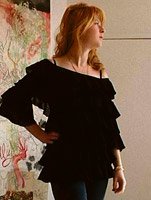Knitter Opens Shop With an Eye on L.A.'s Designer Market
Behind an unassuming door in an unassuming building in Los Angeles’ fashion district lies the holy grail of domestic knitters—a knitter specializing in high-end fabrications with no minimums. Since opening its doors in October 2006, boutique knitting company PDR Knitting has amassed an impressive list of clients. FromMadley to Tart, Hazel Brown, Aristocracy and Anzevino & Florence, up-and-coming contemporary brands are flocking to the fledgling knitting facility to take advantage of PDR’s unique offerings.
“We’re offering something very special,” said Evita Chu, who partnered with old friend Leah Walton to open PDR. Offering privatelabel knitwear and sweaters for designers, PDR’s services also include design help and consultation, sample making, no-minimum production on fully fashioned and cut-andsew knits, domestic and international sourcing, and technical packages for designers who produce overseas. “We can do anything from act like a sample room for designers to fixing garments that come in from overseas with damage,” Walton said. But it’s the no-minimum domestic production and willingness to get creative that gets designers’ engines running.
“Finding a knitter in Los Angeles is like searching for the Loch Ness Monster. It’s believing in a myth. I spent one whole year looking [for my previous knitter],” said Coryn Madley, the Los Angeles–based designer of 5-year-old knit brand Madley and the owner of a Venice Beach, Calif.–based boutique of the same name. “There are knitters for brands doing large quantities, but finding a knitter who will do smaller quantities and one-of-a-kind pieces is nearly impossible,” she said. Madley, whose designs are quirky and embellished, described taking her samples (which Walton has done for the last two years) to manufacturers only to be turned away because of the intricacy of the designs. “I do a lot of ruffles, inverted pleats and plating, so the inside of a garment is different from the outside, just a lot of embellishment—and a lot of knitters shy away from that,” she said. In some cases, Madley found herself knitting when contractors declined her orders. PDR, however, has stepped up to the challenge. Doing handcrocheted edges, one-off pieces and a complex pleating technique Madley designed herself, the new knitting company seems to be up for whatever the designer can throw at them.
Designer Kara Smith of the Santa Barbara, Calif.–based contemporary brand Karanina sought PDR out to help her launch a new collection of knits for Fall 2007. For her, PDR’s willingness to work with her choice of yarn sold her on the contractor. “We want to work with bamboo, and they were able to accommodate us while providing quality and small quantities. That was a big factor for us,” Smith said, noting that while Karanina is testing the knits market, it will be judicious in its orders. With 12 pieces in six colorways, “It’s risky to do 100 pieces of everything, and a lot of knitters’ minimum orders were pretty intense,” the designer said. Some knitters asked for 100 or 500 of every style in every color. “With PDR, you can mix and match, depending on what you need. And the price is reasonable,” she said. Karanina’s knits have special details, such as knit buttons, that other knitters said would have to be sent out and would jack up the price. “But we want the same hands to touch everything, and PDR will do it all in-house,” Smith said.
Stitch by stitch
For Walton and Chu, who met when Chu was a student of Walton’s at the Otis College of Art and Design, owning a factory has always been a goal. Walton—who still teaches at Otis and designs Leah Patra, her own knits line—said she always encouraged her students to start their own businesses. “I’ve always liked the idea that with the right knowledge and business approach, small designers could go into business for themselves,” she said. Chu, who studied business at the University of Southern California, owned a bridal boutique for six years before attending the Fashion Institute of Design & Merchandising and Otis. “I originally wanted a bridal factory,” Chu explained, but after graduating from FIDM she pursued a career in design. Her first job was as a sweater designer, but her boss trained her in the logistics of production. Chu’s next job found her managing imports for a Chinese company producing in Taiwan, and most recently, Chu worked as a designer for a domestic knitter. “I wasn’t happy, and Leah kept telling me to quit,” Chu laughed.
Now, with a handful of employees and knitting machines steadily making everything from felted handbags to sample cardigans with leather insets, PDR is in the middle of its first production cycle. The contractor has the capacity to make 1,500 units per month, so Chu and Walton are looking to grow slowly and by word of mouth. PDR’s output for the first two months of 2007 tallied up to 165 pieces and was three times Chu’s initial projection. By mid-summer Chu said she hopes to more than double the number of knitting machines in her studio and establish separate sample and production teams to help production run smoothly.
Walton said PDR is able to do the seemingly impossible due to a smart business plan. “We’re not in debt buying a lot of machinery. We don’t have a lot of overhead,” she said. What they do have are a small, experienced team and some serious knit know-how. And, unlike other local knitters who find their time monopolized by huge orders from big brands, by catering to smaller brands with smaller orders, PDR can accommodate a variety of clients with unique needs. “That keeps our prices extremely competitive,” Walton said. PDR charges $25 per hour for samples and $25 per hour for technical packages. Production prices vary depending on the job, but they are on par with other knit contractors’ prices. Nurturing brands gives the teacher in Walton a rise. “We like helping out the little guys, and we want to do it while keeping our integrity. You hear so many horror stories,” Walton said, relaying a current client’s experience with another knitter who held the client’s yarn hostage before disappearing.
Next up for PDR, Chu said, is a foray into the design and production of knit fabrics. “There is a great need for cashmere panels in custom colors and custom gauges,” she said. “We’re still in the research stage, but it looks like that is our next big project.”
























